Схожі новини
 Internews’ annual media consumption survey shows a dramatic drop in Ukrainians’ use of Russian media. The survey shows that Russian TV viewership shrank to 8% from 27% in 2014, and Russian internet use slid to 27% in 2015 from 44% in 2014. While lower consumption rates for Russian TV might be partially explained by the Ukrainian government’s initiative to ban transmissions of Russian TV signals within the country, internet access has not been restricted.
Internews’ annual media consumption survey shows a dramatic drop in Ukrainians’ use of Russian media. The survey shows that Russian TV viewership shrank to 8% from 27% in 2014, and Russian internet use slid to 27% in 2015 from 44% in 2014. While lower consumption rates for Russian TV might be partially explained by the Ukrainian government’s initiative to ban transmissions of Russian TV signals within the country, internet access has not been restricted.
 Internews commissioned a qualitative research on implementation of media literacy course in secondary schools of Ukraine. The study held in March-April 2015, aimed surveying teachers and students at root level to understand barriers and prospective in applying media literacy course at practice.
Internews commissioned a qualitative research on implementation of media literacy course in secondary schools of Ukraine. The study held in March-April 2015, aimed surveying teachers and students at root level to understand barriers and prospective in applying media literacy course at practice.
Conducted in cooperation with European Research Association (ERA), the research revealed that media education in secondary schools is implemented through successful combination of efforts of Academy of Ukrainian Press that trained OIPE coordinators/teachers at its schools and the Institute for Social and Political Psychology of National Academy for Pedagogical Sciences that developed the national experiment for 80 schools of 10 oblasts of Ukraine.
 Telekritia published English translation of its survey of media consumers in eastern and southern regions of Ukraine. The survey conducted by Kyiv International Institute of Sociology (KIIS) aimed analyzing an influence of Russian propaganda on eastern regions of Ukraine including occupied areas. Researchers also asked about people's perception of political situation in Ukraine. The Telekritika/KIIS survey was supported by the Department for Rights and Labour (DRL) of US Department of State through Internews Network.
Telekritia published English translation of its survey of media consumers in eastern and southern regions of Ukraine. The survey conducted by Kyiv International Institute of Sociology (KIIS) aimed analyzing an influence of Russian propaganda on eastern regions of Ukraine including occupied areas. Researchers also asked about people's perception of political situation in Ukraine. The Telekritika/KIIS survey was supported by the Department for Rights and Labour (DRL) of US Department of State through Internews Network.

Internews published needs assessment report “UNDERSTANDING INFORMATION AND COMMUNICATION NEEDS AMONG IDPs IN EASTERN UKRAINE that resulted from the 2-week trip of Internews Senior Humanitarian Advisor Jacobo Quintanilla and Internews Ukraine project manager Vitali Moroz to the East of Ukraine. From January 20-30, 2015, an Internews assessment team carried out a rapid assessment with displaced populations and host communities in eastern Ukraine to understand their information needs and access to communication channels.
 August 2014 - Internews publisized an online survey of Ukrainian journalists to study journalists’ conception of standards of journalism, interaction with media audience, journalists’ perception of condition of freedom of speech, external and internal factors, that have an influence on quality of journalists’ work and implementation of their role in society, including labor relations, level of job compensation, ethical principles of journalism, level of journalists’ professional knowledge and knowledge of media legislation concerning access to public information, defamation, handling with personal data etc.
August 2014 - Internews publisized an online survey of Ukrainian journalists to study journalists’ conception of standards of journalism, interaction with media audience, journalists’ perception of condition of freedom of speech, external and internal factors, that have an influence on quality of journalists’ work and implementation of their role in society, including labor relations, level of job compensation, ethical principles of journalism, level of journalists’ professional knowledge and knowledge of media legislation concerning access to public information, defamation, handling with personal data etc.
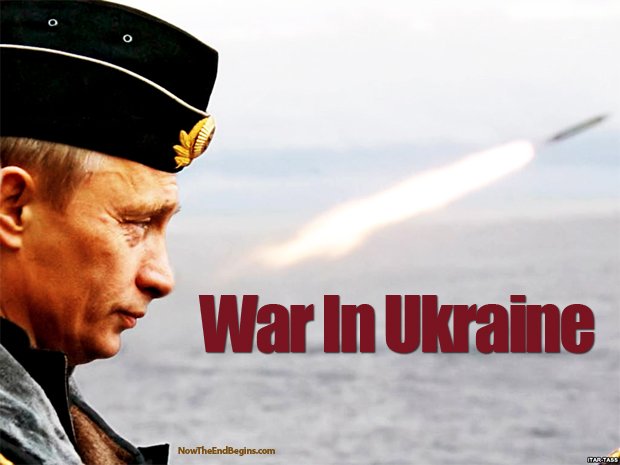 MediaSapiens translated analytical overview about Russian media coverage of war conflict in Eastern Ukraine. Read about lie and falsifications in Russian news spread through TV channels and online media. Photo credit: http://www.nowtheendbegins.com
MediaSapiens translated analytical overview about Russian media coverage of war conflict in Eastern Ukraine. Read about lie and falsifications in Russian news spread through TV channels and online media. Photo credit: http://www.nowtheendbegins.com
 New research reveals that a clear majority of Ukrainians in Donetsk oblast (region) are watching both Ukrainian and Russian TV news, although trust levels of the population in Ukrainian TV is low. . Around the rest of the country, people prefer to get their news from Ukrainian TV channels. The survey in 10 regions of Ukraine was commissioned by Internews and conducted from April to June 2014 by marketing and research firm InMind for the USAID-funded Ukraine Media Project (U-Media).
New research reveals that a clear majority of Ukrainians in Donetsk oblast (region) are watching both Ukrainian and Russian TV news, although trust levels of the population in Ukrainian TV is low. . Around the rest of the country, people prefer to get their news from Ukrainian TV channels. The survey in 10 regions of Ukraine was commissioned by Internews and conducted from April to June 2014 by marketing and research firm InMind for the USAID-funded Ukraine Media Project (U-Media).
 The Internews is seeking a Content Analysis Expert /Expert Group to assist in implementation of a three-year project Strengthening Investigative Reporting in Ukraine (SIRU). The Content Analysis Expert /Expert Group will analyze the quality of investigative reports produced by Internews implementing partners and provide recommendations on quality improvement.
The Internews is seeking a Content Analysis Expert /Expert Group to assist in implementation of a three-year project Strengthening Investigative Reporting in Ukraine (SIRU). The Content Analysis Expert /Expert Group will analyze the quality of investigative reports produced by Internews implementing partners and provide recommendations on quality improvement.
- У-Медіа » English » Media Research » Despite disillusionment with Ukrainian government, 84% of residents from East and South want Donbass remain Ukrainian
- Переглядів: 1305
- Автор: rfgtw
- Дата: 8-04-2015
Despite disillusionment with Ukrainian government, 84% of residents from East and South want Donbass remain Ukrainian
Категорія: English » Media Research

Kyiv International Institute of Sociology conducted a survey «Counteraction to Russian Propaganda in the Conflict Region» by the order of NGO Telekritika. Interviews were held from February 26 to February 28, 2015 and covered citizens of five regions - Kharkiv, Odesa, Kherson, Donetsk, and Luhansk including the occupied areas.
Key findings
- The study showed, that residents of southern and eastern regions use television as a main source of information about Ukraine: 83% of the respondents receive news from the national TV channels. About 1/3 of respondents watch Russian TV channel “RTR”; Russian TV channels “NTV” and “ORT” have the same indexes; 17% of the respondents receive “RBK.”
- The most demanded information in the ATO zone is about disappeared civilians and Ukrainian soldiers, local and state power actions.
- Residents of south and east gradually experience escalating disillusionment with any media content. Residents of Ukrainian control areas believe Ukrainian sources and consider Russian media to be biased and nonobjective.
- Residents of ossupied areas - People’s Republic of Donetsk (PRD) and People’s Republic of Luhansk (PRL) - have opposite perception and do not trust to Ukrainian media.
- Russian propaganda is steadily winning at the occupied territories. Other south-eastern regions demonstrate no support for the messages of Russian propaganda. The least popular are the messages like “Maidan is a fascist revolution.” The latter is supported by 27% and not supported by 54%.
- The assessment of the Maidan outcomes is rather pessimistic. The overwhelming majority (66%) think that the main consequences of Maidan are the annexation of the Crimea, the war conflict in Donbas and the economic breakdown in Ukraine. The opponents make up only 15%.
- Despite the disillusionment with the Ukrainian power, the ideas of separatism at the territories under Ukrainian control have not taken root. 84% consider that Donbas should remain a part of Ukraine. As for “people’s republics,” 50% would like to separate, while another 50% are likely to scrutinize the opportunity to remain within Ukraine provided that the status of the territory is changed.
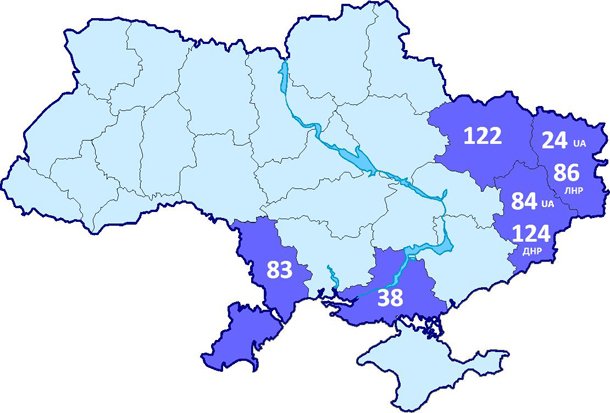
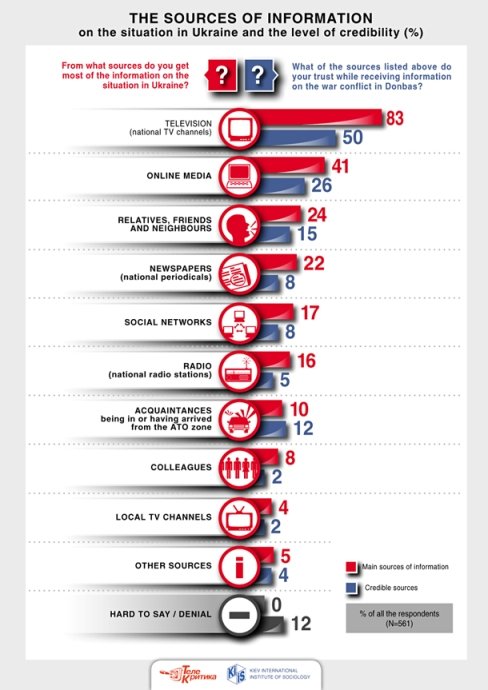
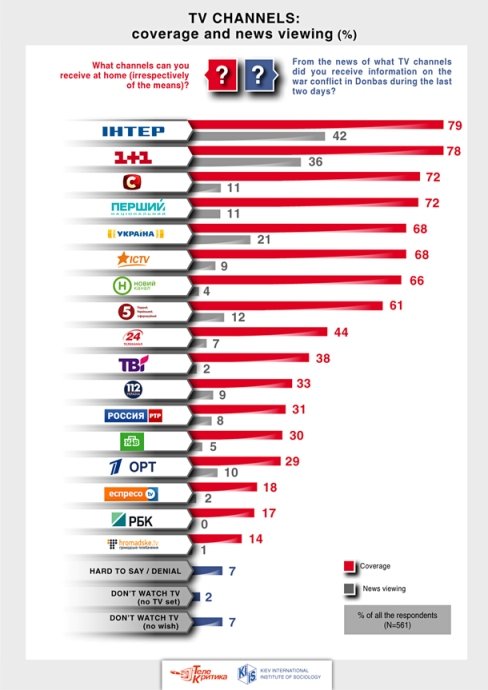
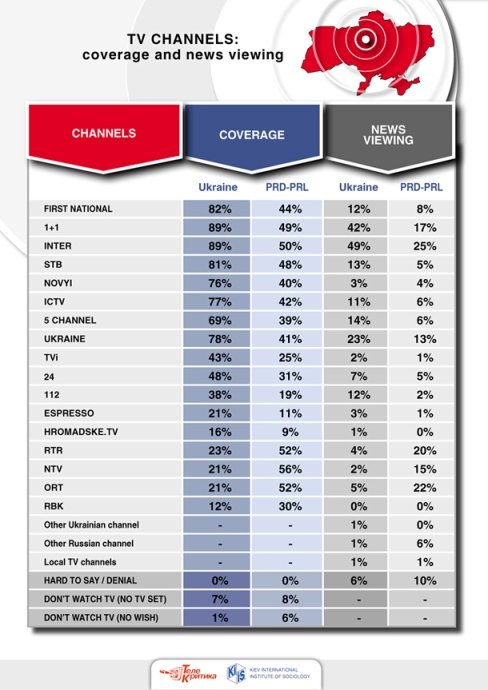
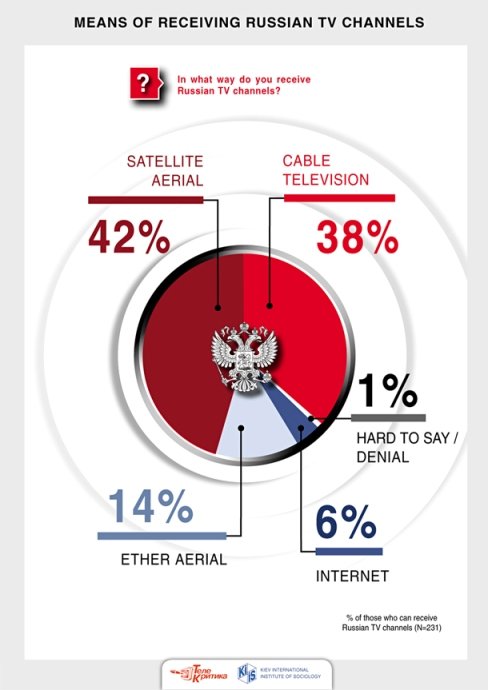
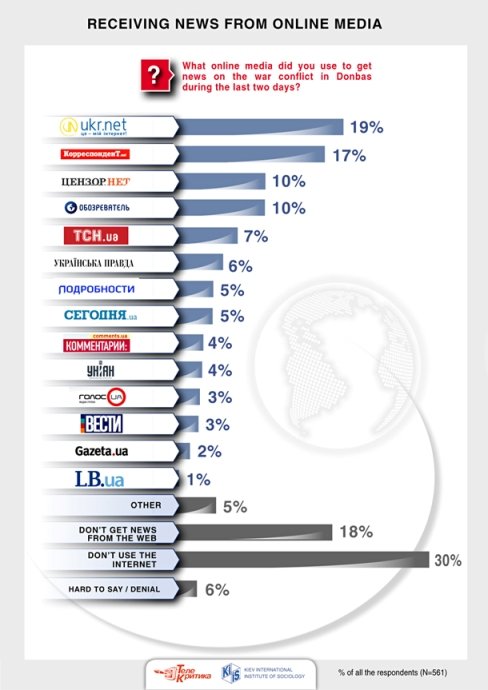
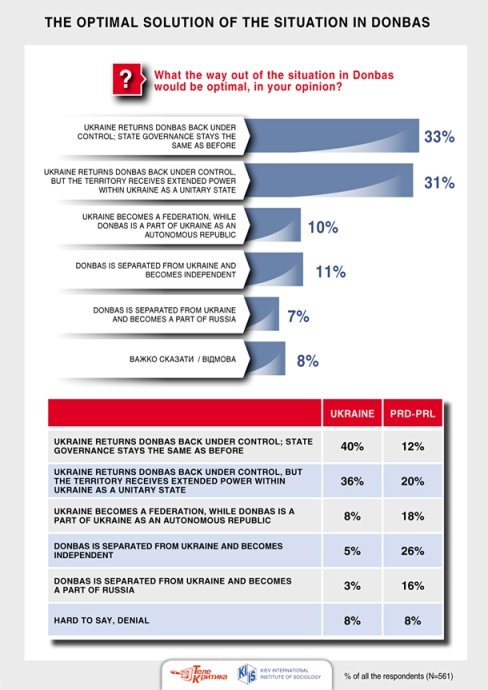
Analytical report on the study “Counteraction to Russian Propaganda in the Conflict Region” is avaible online at http://osvita.mediasapiens.ua/monitoring/in_english/analytical_report_on_the_study_counteraction_to_russian_propaganda_in_the_conflict_region
The sample of the survey is representative for adult urban population of five oblasts: Kharkiv, Odesa, Kherson, Donetsk, and Luhansk (including the regions being at entry out of the Ukrainian control). All in all, there were 561 interviews conducted in 124 communities by the CATI method (computer-assisted telephone interviewing).
The representation sample is stratified according to oblast and community type (regional centre, cities with population over 100,000 inhabitants, cities with population from 20,000 to 99,000 inhabitants, towns with population less than 20,000 inhabitants). Besides, Donetsk and Luhansk oblasts were divided into the territory under the Ukrainian control and the territory controlled by «People’s Republic of Donetsk» (PRD) or «People’s Republic of Luhansk» (PRL). Several random telephone numbers were selected from the database within each stratum. A quota selection of respondents by gender and age was applied at the last phase of the survey. The influence of inner migration from the ATO zone on the actual number of population in each oblast was calculated according to the public information of the UN Refugee Agency. The survey has taken to account the UN Refugee Agency information on the percentage of inner migrants in other oblasts and the results of the previous KIIS studies intended to find out the amounts and direction of migration from «People’s Republic of Donetsk,» «People’s Republic of Luhansk» and front line territories of Donetsk and Luhansk oblasts. Therefore, the ratio of respondents from PRD and PRL has been reduced from 37% to 27%.

